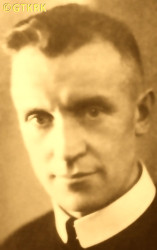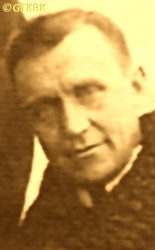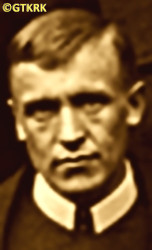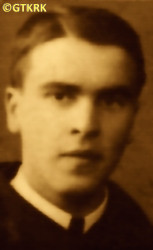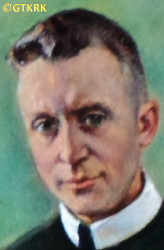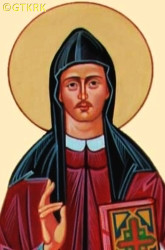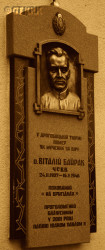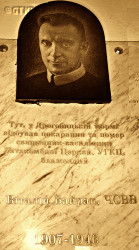Roman Catholic
St Sigismund parish
05-507 Słomczyn
85 Wiślana Str.
Konstancin deanery
Warsaw archdiocese, Poland
full list:
displayClick to display full list

searchClick to search full list by categories
wyświetlKliknij by wyświetlić pełną listę po polsku

szukajKliknij by przeszukać listę wg kategorii po polsku

Martyrology of the clergy — Poland
XX century (1914 – 1989)
personal data
religious status
blessed
surname
BAJRAK
forename(s)
Vladimir (pl. Włodzimierz)
religious forename(s)
Vitalis (pl. Witalis)
beatification date
27.06.2001more on
www.swzygmunt.knc.pl
[access: 2013.05.19]

the RC Pope John Paul IImore on
en.wikipedia.org
[access: 2014.09.21]
function
religious cleric
creed
Ukrainian Greek Catholic GCmore on
en.wikipedia.org
[access: 2013.05.19]
congregation
Basilian Order of Saint Josaphat OSBMmore on
en.wikipedia.org
[access: 2014.09.21]
(i.e. Basilians)
diocese / province
Holiest Redeemer province OSBM (Galicia)
Przemyśl GC eparchymore on
pl.wikipedia.org
[access: 2013.05.19]
nationality
Ukrainian
date and place
of death
16.05.1946

Drohobychtoday: Drohobych urban hrom., Drohobych rai., Lviv obl., Ukraine
more on
en.wikipedia.org
[access: 2021.10.09]
details of death
After the German and Russian invasion of Poland in 09.1939 and the start of World War II, during Russian occupation, resided in the monastery in Zhovkva.
After the German attack on 22.06.1941 on the erstwhile ally, the Russians, and the beginning of the German occupation, became prob. in 1941 hegumen–superior of the monastery in Drohobych — in place of hegumen Severine Stephen Baranyk and protohegumen (provincial superior, residing in Drohobych), Joachim John Sieńkiwski, murdered in 06.1941 by the Russians.
For the next two years prob. often left Drohobych for the areas inhabited by Lemkos — in 1939‐1941 occupied by the Germans — and ministered there in several small parishes.
After start of another Russian occupation on 08.08.1944 forced by the Russians to leave his monastery in Drohobych (the Russians first organized a transit point for repressed people there, and later a student club). In addition the monastery church in 1945 — prob. after mass arrests of Greek Catholic bishops by the Russians on 11.04.1945 — was taken over by the Russian Orthodox church.
On 17.09.1945 arrested by the Russians.
Held in Drohobych prison.
Accused that „during German occupation participated in funeral prayers for former soldiers of Ukrainian Galician Army UHA that battled for independent Ukraine after the end of the World War I […], critique of Russian [policies] in [missionary calendars of 1942]”.
On 13.11.1945 sentenced to 8 years of slave labour in Russian concentration camps Gulag.
Before deportation though beaten up by the Russians and perished in prison.
cause of death
murder
perpetrators
Russians
sites and events
Prison massacres — Drohobych 06.1941Click to display the description, 06.1941 massacres (NKVD)Click to display the description, Drohobych (prisons)Click to display the description, GeneralgouvernementClick to display the description, Ribbentrop‐MolotovClick to display the description, Pius XI's encyclicalsClick to display the description
date and place
of birth
24.02.1907

Shvaykivtsitoday: Zavodske hrom., Chortkiv rai., Ternopil obl., Ukraine
more on
en.wikipedia.org
[access: 2022.08.05]
parents
BAJRAK Vasil
🞲 ?, ? — 🕆 ?, ?

Anne
🞲 ?, ? — 🕆 ?, ?
religious vows
28.02.1933 (permanent)
presbyter (holy orders)
ordination
13.08.1933

Zhovkvatoday: Zhovkva urban hrom., Lviv rai., Lviv obl., Ukraine
more on
en.wikipedia.org
[access: 2020.11.22]
Sacred Heart of Jesus GC churchmore on
pl.wikipedia.org
[access: 2022.12.13]
positions held
1944 – 1945
administrator — Boryslavtoday: Boryslav urban hrom., Drohobych rai., Lviv obl., Ukraine
more on
en.wikipedia.org
[access: 2020.11.01] ⋄ Our Lord's Resurrection GC parish ⋄ Boryslavtoday: Boryslav urban hrom., Drohobych rai., Lviv obl., Ukraine
more on
en.wikipedia.org
[access: 2020.11.01] GC deanery — catechist and teacher at a local school
1943 – 1944
hegumen–superior — Drohobychtoday: Drohobych urban hrom., Drohobych rai., Lviv obl., Ukraine
more on
en.wikipedia.org
[access: 2021.10.09] ⋄ Basilians OSBM ⋄ Holy Trinity GC monastery — also: prefect, chaplain of the local hospital
1942 – 1943
administrator — Beskotoday: Besko gm., Sanok pov., Subcarpathia voiv., Poland
more on
en.wikipedia.org
[access: 2021.12.18] ⋄ Nativity of the Blessed Virgin Mary GC parish ⋄ Rymanówtoday: Rymanów gm., Krosno pov., Subcarpathia voiv., Poland
more on
en.wikipedia.org
[access: 2021.10.09] GC deanery — also: catechist
1942
administrator — Wróblik Królewskitoday: Rymanów gm., Krosno pov., Subcarpathia voiv., Poland
more on
en.wikipedia.org
[access: 2021.12.18] ⋄ Basilians OSBM ⋄ Dormition of the Blessed Virgin Mary GC parish ⋄ Rymanówtoday: Rymanów gm., Krosno pov., Subcarpathia voiv., Poland
more on
en.wikipedia.org
[access: 2021.10.09] GC deanery — also: catechist
till 1941
monk and parish priest — Zhovkvatoday: Zhovkva urban hrom., Lviv rai., Lviv obl., Ukraine
more on
en.wikipedia.org
[access: 2020.11.22] ⋄ Basilians OSBM ⋄ Nativity of Christ GC monastery ⋄ Nativity of the Blessed Virgin Mary GC parish ⋄ Zhovkvatoday: Zhovkva urban hrom., Lviv rai., Lviv obl., Ukraine
more on
en.wikipedia.org
[access: 2020.11.22] GC deanery — deputy hegumen–superior
from 1936
monk and vicar — Zhovkvatoday: Zhovkva urban hrom., Lviv rai., Lviv obl., Ukraine
more on
en.wikipedia.org
[access: 2020.11.22] ⋄ Basilians OSBM ⋄ Nativity of Christ GC monastery ⋄ Nativity of the Blessed Virgin Mary GC parish ⋄ Zhovkvatoday: Zhovkva urban hrom., Lviv rai., Lviv obl., Ukraine
more on
en.wikipedia.org
[access: 2020.11.22] GC deanery
1933 – 1936
monk — Buchachtoday: Buchach urban hrom., Chortkiv rai., Ternopil obl., Ukraine
more on
en.wikipedia.org
[access: 2020.11.15] ⋄ Basilians OSBM ⋄ Exaltation of the Lord's Cross GC monastery
1931 – 1933
student — Krystynopiltoday: Sheptytskyi, Sheptytskyi urban hrom., Sheptytskyi rai., Lviv obl., Ukraine
more on
en.wikipedia.org
[access: 2022.08.05] ⋄ Theological Study, Basilians OSBM ⋄ St George GC monastery
1929 – 1931
student — Dobromyltoday: Dobromyl urban hrom., Sambir rai., Lviv obl., Ukraine
more on
en.wikipedia.org
[access: 2021.10.09] ⋄ Philosophical and Theological Studies, Basilians OSBM ⋄ St Onuphrius GC monastery
1927 – 1929
student — Lavrivtoday: Staryi Sambir urban hrom., Sambir rai., Lviv obl., Ukraine
more on
en.wikipedia.org
[access: 2022.08.06] ⋄ Philosophical Study, Basilians OSBM ⋄ St Onuphrius GC monastery
novitiate — Krekhivtoday: Zhovkva urban hrom., Lviv rai., Lviv obl., Ukraine
more on
en.wikipedia.org
[access: 2022.08.06] ⋄ St Nicholas GC monastery, Basilians OSBM
04.09.1924
accession — Basilians OSBM
others related
in death
BARANYKClick to display biography Steven (Fr Severin), SIEŃKIWSKIClick to display biography John (Fr Joachim)
sites and events
descriptions
Prison massacres — Drohobych 06.1941: After German attack of Russians on 22.06.1941 Russians murdered prisoners held in Drohobych Stryjska Str. investigative jail. The exact number of victims remains unknown — after German attack Russians brought many prisoners (c. 300) from nearby villages and did not even manage to register them. In the last days of 06.1941 Russian genocidal NKVD forced the prisoners onto the prison yard informing the inmates of impending release. When all congregated there from the guard towers they were slaughter by machine guns fire. Under stack of bodies four people survived. Altogether Russians together with a number of Jews eagerly helping them murdered then c. 1,200 people (though some might have been murdered earlier). (more on: pl.wikipedia.orgClick to attempt to display webpage
[access: 2017.03.24])
06.1941 massacres (NKVD): After German attack of Russian‐occupied Polish territory and following that of Russia itself, before a panic escape, Russians murdered — in accordance with the genocidal order issued on 24.06.1941 by the Russian interior minister Lawrence Beria to murder all prisoners (formally „sentenced” for „counter‐revolutionary activities”, „anti‐Russian acts”, sabotage and diversion, and political prisoners „in custody”), held in NKVD‐run prisons in Russian occupied Poland, Lithuania, Latvia and Estonia — c. 40,000‐50,000 prisoners. In addition Russians murdered many thousands of victims arrested after German attack regarding them as „enemies of people” — those victims were not even entered into prisons’ registers. Most of them were murdered in massacres in the prisons themselves, the others during so‐called „death marches” when the prisoners were driven out east. After Russians departure and start of German occupation a number of spontaneous pogroms of Jews took place. Many Jews collaborated with Russians and were regarded as co‐responsible for prison massacres. (more on: en.wikipedia.orgClick to attempt to display webpage
[access: 2021.12.19])
Drohobych (prisons): Before the outbreak of the World War II in 09.1939 a criminal prison functioned at Drohobych Truskawiecka Str. where c. 1,200‐1,500 inmates were held. After the start in 09.1939 of the first Russian occupation a new jail run by Russian NKVD genocidal organization was opened at Striyska Str. (by regional NKVD headquarters). There in 06.1941, after German attack of their erstwhile ally, Russians, NKVD perpetrated a genocidal massacre of prisoners. After German defeat and start in 1944 of another Russian occupation NKVD returned to the same buildings and again opened their jail, where hundreds and thousands of people suspected of not supporting Russia were held and interrogated. The jail was closed in 1959. The prison at Truskawiecka Str. however remained open throughout the World War II, both during Russian and German occupations, stayed open after the end of military hostilities and operates till today. (more on: btx.home.plClick to attempt to display webpage
[access: 2020.04.04])
Generalgouvernement: After the Polish defeat in the 09.1939 campaign, which was the result of the Ribbentrop‐Molotov Pact and constituted the first stage of World War II, and the beginning of German occupation in part of Poland (in the other, eastern part of Poland, the Russian occupation began), the Germans divided the occupied Polish territory into five main regions. In two of them new German provinces were created, two other were incorporated into other provinces. However, the fifth part was treated separately, and in a political sense it was supposed to recreate the German idea from 1915 (during World War I, after the defeat of the Russians in the Battle of Gorlice in 05.1915) of creating a Polish enclave within Germany. Illegal in the sense of international law, i.e. Hague Convention, and public law, managed by the Germans according to separate laws — especially established for the Polish Germ. Untermenschen (Eng. subhumans) — till the Russian offensive in 1945 it constituted part of the Germ. Großdeutschland (Eng. Greater Germany). Till 31.07.1940 formally called Germ. Generalgouvernement für die besetzten polnischen Gebiete (Eng. General Government for the occupied Polish lands) — later simply Germ. Generalgouvernement (Eng. General Governorate), as in the years 1915‐1918. From 07.1941, i.e. after the German attack on 22.06.1941 against the erstwhile ally, the Russians, it also included the Galicia district, i.e. the Polish pre‐war south‐eastern voivodeships. A special criminal law was enacted and applied to Poles and Jews, allowing for the arbitrary administration of the death penalty regardless of the age of the „perpetrator”, and sanctioning the use of collective responsibility. After the end of the military conflict of the World War UU, the government of the Germ. Generalgouvernement was recognized as a criminal organization, and its leader, governor Hans Frank, guilty of war crimes and crimes against humanity and executed. (more on: en.wikipedia.orgClick to attempt to display webpage
[access: 2024.12.13])
Ribbentrop‐Molotov: Genocidal Russian‐German alliance pact between Russian leader Joseph Stalin and German leader Adolf Hitler signed on 23.08.1939 in Moscow by respective foreign ministers, Mr. Vyacheslav Molotov for Russia and Joachim von Ribbentrop for Germany. The pact sanctioned and was the direct cause of joint Russian and German invasion of Poland and the outbreak of the World War II in 09.1939. In a political sense, the pact was an attempt to restore the status quo ante before 1914, with one exception, namely the „commercial” exchange of the so‐called „Kingdom of Poland”, which in 1914 was part of the Russian Empire, fore Eastern Galicia (today's western Ukraine), in 1914 belonging to the Austro‐Hungarian Empire. Galicia, including Lviv, was to be taken over by the Russians, the „Kingdom of Poland” — under the name of the General Governorate — Germany. The resultant „war was one of the greatest calamities and dramas of humanity in history, for two atheistic and anti‐Christian ideologies — national and international socialism — rejected God and His fifth Decalogue commandment: Thou shall not kill!” (Abp Stanislav Gądecki, 01.09.2019). The decisions taken — backed up by the betrayal of the formal allies of Poland, France and Germany, which on 12.09.1939, at a joint conference in Abbeville, decided not to provide aid to attacked Poland and not to take military action against Germany (a clear breach of treaty obligations with Poland) — were on 28.09.1939 slightly altered and made more precise when a treaty on „German‐Russian boundaries and friendship” was agreed by the same murderous signatories. One of its findings was establishment of spheres of influence in Central and Eastern Europe and in consequence IV partition of Poland. In one of its secret annexes agreed, that: „the Signatories will not tolerate on its respective territories any Polish propaganda that affects the territory of the other Side. On their respective territories they will suppress all such propaganda and inform each other of the measures taken to accomplish it”. The agreements resulted in a series of meeting between two genocidal organization representing both sides — German Gestapo and Russian NKVD when coordination of efforts to exterminate Polish intelligentsia and Polish leading classes (in Germany called «Intelligenzaktion», in Russia took the form of Katyń massacres) where discussed. Resulted in deaths of hundreds of thousands of Polish intelligentsia, including thousands of priests presented here, and tens of millions of ordinary people,. The results of this Russian‐German pact lasted till 1989 and are still in evidence even today. (more on: en.wikipedia.orgClick to attempt to display webpage
[access: 2015.09.30])
Pius XI's encyclicals: Facing the creation of two totalitarian systems in Europe, which seemed to compete with each other, though there were more similarities than contradictions between them, Pope Pius XI issued in 03.1937 (within 5 days) two encyclicals. In the „Mit brennender Sorge” (Eng. „With Burning Concern”) published on 14.03.1938, condemned the national socialism prevailing in Germany. The Pope wrote: „Whoever, following the old Germanic‐pre‐Christian beliefs, puts various impersonal fate in the place of a personal God, denies the wisdom of God and Providence […], whoever exalts earthly values: race or nation, or state, or state system, representatives of state power or other fundamental values of human society, […] and makes them the highest standard of all values, including religious ones, and idolizes them, this one […] is far from true faith in God and from a worldview corresponding to such faith”. On 19.03.1937, published „Divini Redemptoris” (Eng. „Divine Redeemer”), in which criticized Russian communism, dialectical materialism and the class struggle theory. The Pope wrote: „Communism deprives man of freedom, and therefore the spiritual basis of all life norms. It deprives the human person of all his dignity and any moral support with which he could resist the onslaught of blind passions […] This is the new gospel that Bolshevik and godless communism preaches as a message of salvation and redemption of humanity”… Pius XI demanded that the established human law be subjected to the natural law of God , recommended the implementation of the ideal of a Christian state and society, and called on Catholics to resist. Two years later, National Socialist Germany and Communist Russia came together and started World War II. (more on: www.vatican.vaClick to attempt to display webpage
[access: 2023.05.28], www.vatican.vaClick to attempt to display webpage
[access: 2023.05.28])
sources
personal:
www.swzygmunt.knc.plClick to attempt to display webpage
[access: 2013.05.19], pl.wikipedia.orgClick to attempt to display webpage
[access: 2013.05.19]
original images:
uk.wikipedia.orgClick to attempt to display webpage
[access: 2019.10.13], www.geni.comClick to attempt to display webpage
[access: 2019.10.13], www.dobromyl-monastery.comClick to attempt to display webpage
[access: 2019.10.13], www.youtube.comClick to attempt to display webpage
[access: 2019.10.13], missiopc.blogspot.comClick to attempt to display webpage
[access: 2019.10.13], dds.edu.uaClick to attempt to display webpage
[access: 2019.10.13], catholicencyclopedia.in.uaClick to attempt to display webpage
[access: 2019.10.13], dyvensvit.orgClick to attempt to display webpage
[access: 2014.05.09], hal_zoria.io.uaClick to attempt to display webpage
[access: 2014.05.09]
LETTER to CUSTODIAN/ADMINISTRATOR
If you have an Email client on your communicator/computer — such as Mozilla Thunderbird, Windows Mail or Microsoft Outlook, described at WikipediaPatrz:
en.wikipedia.org, among others — try the link below, please:
LETTER to CUSTODIAN/ADMINISTRATORClick and try to call your own Email client
If however you do not run such a client or the above link is not active please send an email to the Custodian/Administrator using your account — in your customary email/correspondence engine — at the following address:

giving the following as the subject:
MARTYROLOGY: BAJRAK Vladimir
To return to the biography press below:
 Click to return to biography
Click to return to biography








